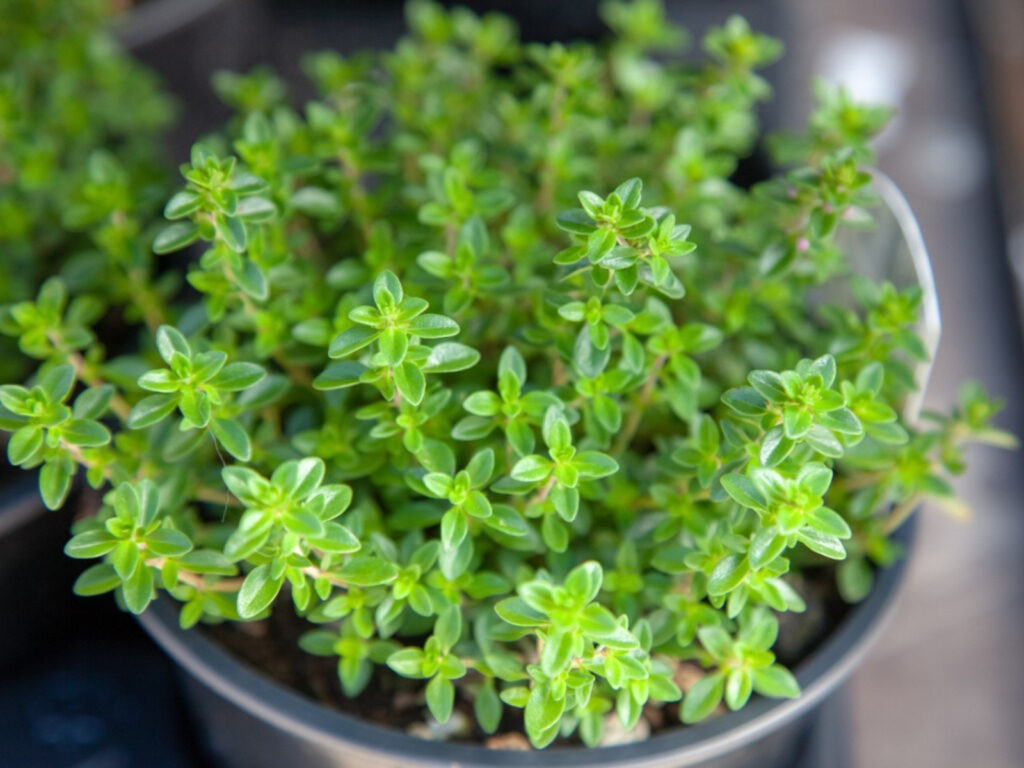It’s About Thyme: A Guide to Growing and Using Thyme in Your Home
By Carmen and Tripp Eldridge

Time is precious but buying pre-packaged or dry herbs won’t save you any “thyme” this fall. A staple in the kitchen and a year-round plant, thyme is the perfect herb to grow yourself ahead of the holiday season. Thyme is an evergreen herb, which means that it can grow in any environment. Whether you’re planting it outside in your herb garden, in a pot on your front stoop, or inside your home, here are some tips on how to grow thyme so you can add some fresh flavors to your dishes year-round.
When growing thyme, space the plants 12 to 24 inches apart in a sunny area with fertile, well-drained soil. Considering South Florida’s year-round warm weather, a sunny spot should be easy to find. Before you transplant your thyme, ensure that your soil is nutrient-rich by mixing in several inches of aged compost.
If you are looking to plant thyme indoors, you are in luck. Thyme is one of the easiest indoor herbs to cultivate and will add a delightful aroma to your home. To start, grab a clay pot with at least one large drainage hole to prevent the roots from getting too wet. While direct sunlight is helpful, thyme can still be grown indoors. Create the right balance of light by placing your pot next to a window that gets at least 6 hours of sunlight a day.
As you tend to your plant, keep the soil moist and water when the top inch of soil becomes dry. As you would with any other herb, do not over-water your plant. The clay pot and drainage hole will help keep your thyme fresh. Use high-quality plant food or organic fertilizers monthly while watering to keep the plant healthy and trim overgrown stems to encourage fresh growth.
As soon as your thyme has plenty of foliage, you can start using it to season your meals. Cut off the stems and rinse them. Remove the leaves from the stem by running your thumb and index finger down the length of the stem or use the back of a knife. Fresh thyme leaves are small so there’s no need to chop them any further.
When you grow thyme in and around your house, you will always have a ready supply of fresh seasoning and smells. Thyme can be added early in any recipe and the flavor will continue to develop as you cook. For soups and sauces, you can tie sprigs of thyme together and put the bundle into your pot to stew (just don’t forget to pull out the stems before you serve or blend). Thyme also pairs well with fish, roasted vegetables, baked goods, and even your Thanksgiving feast.
Once picked, there are several ways you can preserve your thyme sprigs for future use, including refrigeration, freezing, and drying. To refrigerate your thyme, wrap the stems in a slightly damp paper towel and place the bundle in a sealable plastic bag or container. You can place the bag in the crisper drawer for better storage. This method will preserve sprigs for at least a week after picking so you can use fresh thyme for any meal you are preparing throughout the week.
Freezing thyme is the best solution for cooks looking to incorporate thyme into soup starters or added moisture and flavor in stews. Take your freshly picked thyme and place it in an ice cube tray with water. If you have full sprigs leftover, freeze the stems in a sealable bag, which will make it easier for you to use the leaves later.
For dried herbs that are perfect for bottling for exact recipe measurements, leave thyme leaves on a baking sheet on your kitchen counter. The oils from the herbs are also great for adding extra flavor to your dishes.
Now that you have these tips for inspiration, it’s time for you to start growing herbs that will elevate your dishes and make your home smell great year-round. Thyme is the perfect herb to round out your holiday meal and bring some festivity to your home this fall.
***

Carmen and Tripp Eldridge are small-scale farming experts and the current Farm Directors at Arden, an award-winning residential agrihood in Palm Beach County, FL. Managing the community’s five-acre farm, Tripp and Carmen are pioneering innovative farm-to-table living in South Florida.

